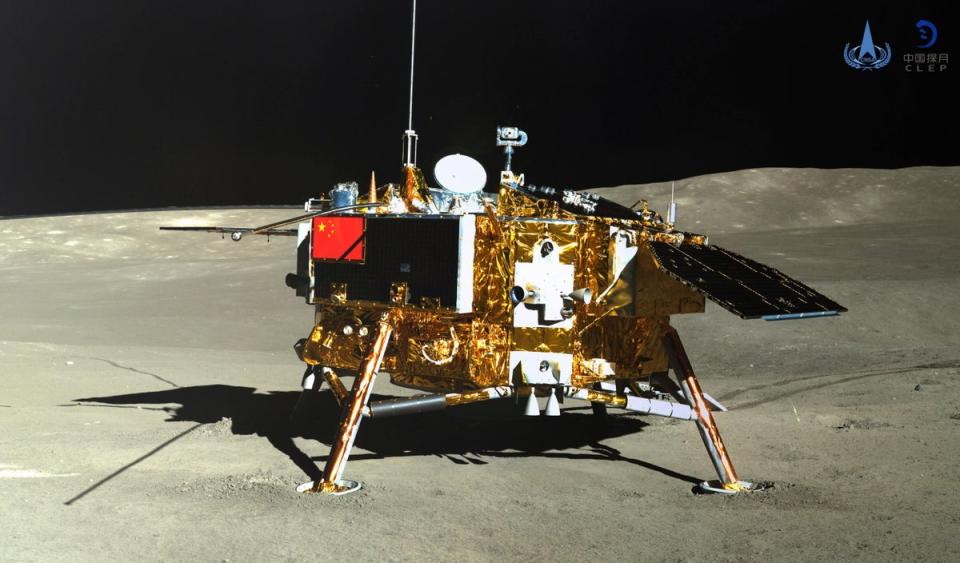China has launched a probe that will fly to the far side of the moon – and bring pieces of it back to Earth.
The Chang’e-6 probe aims to help us better understand the far side of the moon’s surface. The area is difficult to explore, as it is cut off from radio communication with Earth – but it could be a key resource for work such as radio astronomy, as it is shielded from interference from our own planet.
Friday’s rocket launch is the latest and perhaps most spectacular aspect of the country’s efforts to overtake the US in the new space race.
Its own space station is already crewed, and aims to land people on the moon by 2030. But first it needs to get there with landers – three of whom are planned to be sent there in the next four years .

The rocket carrying the Chang’e-6 lunar probe – named after the mythical Chinese moon goddess – took off on Friday at 5.27pm as planned from the Wenchang launch center in the island province of Hainan. About 35 minutes later it completely separated from the rocket that had propelled it into space – the massive Long March 5, China’s largest – to cheers and applause from watching technicians. on the launch from ground control.
Shortly after, the launch mission commander Zhang Zuosheng took to a podium at the front of the room and said that the launch had gone exactly as planned and that the spacecraft was on its set track. “I declare that this launch mission was a complete success,” Zhang said, to further applause.
The Philippine Space Agency issued a statement saying the debris expected from the rocket launch was “anticipated to be within the known fall zones”.
In 2021, China was forced to defend its handling of a rocket booster that burned over the Indian Ocean after officials including the administrator of America’s space agency accused Beijing of acting recklessly by allowing its rocket to fall to Earth. after the mission apparently went out of control.
Crowds flocked to Hainan’s beaches to witness the launch, which came in the middle of China’s five-day May Day holiday. As with recent launches, state broadcaster CCTV broadcast the event live.
After orbiting the moon to reduce its speed, the lander will separate from the spacecraft, and within 48 hours of landing it will begin drilling into the lunar surface and taking samples with its robotic arm. With the samples sealed in a container, it will then reconnect with the return for the journey back to Earth. The entire mission is planned to last 53 days.
In 2020, China returned samples from the side of the moon, the first time anyone had done so since the former Soviet Union in 1976. Analysis of the samples found that they contained water in tiny beads embedded in lunar dirt.
Also in the past week, three Chinese astronauts returned home from a six-month mission on the country’s orbiting space station after the replacement crew arrived.
China built its own space station after being excluded from the International Space Station (ISS), largely due to US concerns about China’s military taking complete control of the space program amid increased technology competition between the two geopolitical rivals. US law prohibits almost all cooperation between the US and Chinese space programs without express permission from congress.
Faced with these limitations, China has expanded cooperation with other countries and agencies. The latest mission carries scientific instruments from France, Italy and the European Space Agency in collaboration with Sweden. A small Pakistani satellite is also on board.
China’s ambitious space program aims to put astronauts on the moon by 2030, return samples from Mars around the same time, and launch three lunar probe missions over the next four years.
Longer-term plans call for a permanent manned base on the lunar surface, although these appear to remain in the conceptual stage.
China carried out its first manned space mission in 2003, becoming the third country after the former Soviet Union and the US to send a person into space using its own resources.
The three-module Tiangong, much smaller than the ISS, was launched in 2021 and completed 18 months later. It can accommodate up to six astronauts at a time, and is primarily dedicated to scientific research. The team will also install space debris protection equipment, conduct payload experiments, and beam science classes to students on Earth.
China also said it plans to eventually offer access to its space station to foreign astronauts and space tourists. As the ISS nears the end of its useful life, China may become the only country or corporation to maintain a manned station in orbit.
The US space program is still believed to have a significant edge over China’s because of its spending, supply chains and capabilities.
The US aims to return astronauts to the lunar surface by 2026 at the earliest. This time, however, NASA is partnering with private companies such as SpaceX and Blue Origin, which will provide the landers for the astronauts.
They plan to land on the moon’s south pole, where a permanent shadowy crater is believed to be packed with frozen water.
Additional reporting from agencies